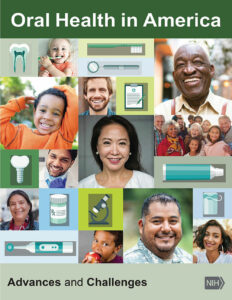Report Details 20 Years of Advances and Challenges in Americans’ Oral Health

Despite important advances in the understanding and treatment of oral diseases and conditions, many people in the United States still have chronic oral health problems and lack of access to care, according to a new report from the National Institutes of Health (NIH). “Oral Health in America: Advances and Challenges” is a follow-up to the seminal 2000 “Oral Health in America: A Report of the Surgeon General.” The new report, which is intended to provide a road map on how to improve the nation’s oral health, draws primarily on information from public research and evidence-based practices, and was compiled and reviewed by NIH’s National Institute of Dental and Craniofacial Research (NIDCR), plus a large, diverse, multidisciplinary team of more than 400 experts.
The report updates the findings of the 2000 publication and highlights the national importance of oral health and its relationship to overall health. It also focuses on new scientific and technological knowledge—as well as innovations in healthcare delivery—that offer promising new directions for improving oral healthcare and creating greater equity in oral health across communities. Achieving equity is an ongoing challenge for many who struggle to obtain dental insurance and access to affordable care.
“This is a very significant report,” notes NIH Acting Director Lawrence A. Tabak, DDS, PhD. “It is the most comprehensive assessment of oral health currently available in the United States and it shows, unequivocally, that oral health plays a central role in overall health. Yet millions of Americans still do not have access to routine and preventive oral care.”
The newly issued report provides a comprehensive snapshot of oral health in America, including an examination of oral health across the lifespan and a look at the impact the issue has on communities and the economy. Major takeaways from the report include:
- Healthy behaviors can improve and maintain an individual’s oral health, but these behaviors are also shaped by social and economic conditions.
- Oral and medical conditions often share common risk factors, and, just as medical conditions and their treatments can influence oral health, oral conditions and their treatments can also affect other health issues.
- Substance misuse and mental health conditions negatively affect the oral health of many.
- Group disparities around oral health, identified 20 years ago, have not been adequately addressed, and greater efforts are needed to tackle both the social and commercial determinants that create these inequities and the systemic biases that perpetuate them.
“This is an in-depth review of the scientific knowledge surrounding oral health that has accumulated over the last two decades,” reports Rena D’Souza DDS, PhD, director of NIDCR, which oversaw and funded the project’s three-year research program. “It provides an important window into how many societal factors intersect to create advantages and disadvantages with respect to oral health, and, critically, overall health.”
The COVID-19 pandemic emerged while the report was being written. The science around SARS-CoV-2 continues to come into focus in real-time, and, although data were only starting to surface about the oral implications of the disease, the authors included a preliminary analysis to assess its initial impacts.
The authors offer several recommendations to improve oral health in America, which include the need for healthcare professionals to work together to provide integrated oral, medical, and behavioral healthcare in schools, community health centers, nursing homes, and medical care settings, as well as dental clinics. They also identify the need to improve access to care by developing a more diverse oral healthcare workforce, addressing the rising cost of dental education, expanding insurance coverage, and improving the overall affordability of care.

